Papers by TIZA MICHAEL. R.Engr.COREN, MNSE, Aff.MASCE,M.IAENG, B.Eng(Nigeria), MBA,M.Tech(India)

The quest to modify the engineering properties of weak or expansive soils seem to be unending as ... more The quest to modify the engineering properties of weak or expansive soils seem to be unending as these expansive soils posse a huge challenge to construction of roads by Highway engineers due to their poor geotechnical properties. Many materials have been attempted with the aim of trying to determine how effective these materials will be in improving the strength characteristics of expansive soils, while many have been found very useful, a few have been found wanting. This review paper is aimed at trying to determine the general effect of Saw Dust Ash (SDA) Silica Fume (SF) and thus, their rate of acceptance or rejection judging from Laboratory experiments conducted by different researchers. It was discovered from the review that 100% of the research in this review recommend Silica fume as stabilizing agent while Saw dust Ash had 87.5% acceptance as stabilizing agent. Key words – Expansive Soil, Silica Fume (SF), Saw Dust Ash (SDA), California Bearing Ratio (CBR), Atterberg's Limit. I. INTRODUCTION Pavement contruction on problematic soils does not only increase the cost of road or highway construction and unsafety but as well creates issues of quick deterioration of pavements which leads to failure even before their design life making an entire work considered as poorly done. It is because of this that construction of roads require expertise with due good experience and knowledge of soil inorder to avert disasters they may emanate as a result of poor construction practices. The numerous lives that are lost on road accidents are partly attributed to poor pavement conditions either due to poor construction practices , poor maintenance and or no maintainance at all. Thus execution of highway projects on soils that are very problematic like those containing high clay proportions which most have high level of disturbance due to a slight alteration due to variation in water content. Such soil needs to be improved upon with the motive of improving the geothecnical properties as good practice bnefore paving process is done. This practice is called soil stabilization. II. SILICA FUME Silica fume is a by-product from production of ferrosilicon or silicon alloys. It has very fineparticles, thus the reason it is also called micro silica fume. It is cementious in nature and extensively used in concrete technology due to its physical and chemical properties. It has been used in many areas of life however because its use is not exhaustive, it still possesses a high challenge of disposal since a large quantity of it comes out as waste products. Researchers have attempted to check its effect as stabilizing agent of expansive soils and some of the results obtained are as shown below. Ishraq (2013) investigatedstudying some of the Geotechnical Properties of Stabilized Iraqi Clayey Soils. The experiments conducted were consistency limits test, specific gravity test, compaction test, unconfined compression test and California bearing ratio test. The optimal percentage of LSF combination was found to be (2.5%L+6.0%SF). Silica fume was thus considered for a modification agent of geotechnical properties of clayey soils. Chhaya et al (2013) did a study on Effect of Silica Fume on Engineering Properties of Black Cotton Soil. It was indicated in the result the CBR had a significant increment and same as UCS.With increase in silica fume from 0% to 20% there was a decrease in differential free swell of the clay from 50% to 7%. There was a decrease in Proctor compaction results with increment in MDD and OMC. It was thus concluded that the silica fume posed the potential of stabilizing expansive soils. They also conducted a research on effect of Silica Fume on Index Properties of Black Cotton Soil also and found that the Liquid limit increased from 54% to 57% while PL decreased from 27.07% to 26.29% when there was an increment in Silica fume content from 5% to 20%. Plasticity Index was noticed to have increased from 26.93% to 30.71% and an increase in shrinkage limit from 7.55%-12.70%, respectively. Differential Free Swell was observed to have decreased from 25% to 7%. Silica fume was thus recommended for use in modification of soil. Chayan and Ravi (2014) studied Influence of Micro Silica Fume on Sub Grade Characteristics of Expansive Soil. Number of laboratory tests were conducted and it was proven that the material is good agent of stabilization of expansive soils for sub-grade
Abstract – This research deals with the effects of using rice husk ash (RHA) as a partial weight ... more Abstract – This research deals with the effects of using rice husk ash (RHA) as a partial weight of cement replacement in concrete roof tile production. The work is based on an experimental study of roof tiles produced with ordinary Portland cement (OPC) and 5 %,10 %, 15 % , 20 % and 25 % (OPC) replaced by RHA. The rice husk ash used was produced by open air burning the rice husk. The tests which were performed evaluate the performance of this material were: specific gravity normal consistency, setting time, compressive strength, rupture strength and water absorption. The results show that addition of RHA show better results for 10 % replacement level than OPC at 28 days.
This research deals with the effects of using rice husk ash (RHA) as a partial weight of cement r... more This research deals with the effects of using rice husk ash (RHA) as a partial weight of cement replacement in concrete roof tile production. The work is based on an experimental study of roof tiles produced with ordinary Portland cement (OPC) and 5 %,10 %, 15 % , 20 % and 25 % (OPC) replaced by RHA. The rice husk ash used was produced by open air burning the rice husk. The tests which were performed evaluate the performance of this material were: specific gravity normal consistency, setting time, compressive strength, rupture strength and water absorption. The results show that addition of RHA show better results for 10 % replacement level than OPC at 28 days.
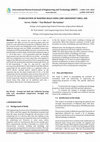
This research was carried out in other to investigate the effect of Lime (L) and Groundnut shell ... more This research was carried out in other to investigate the effect of Lime (L) and Groundnut shell ash (GSA) on some geotechnical properties of Makurdi shale. In this research work, soil classification tests, Compaction test, California bearing ratio test (CBR), unconfined compressive strength test (UCS) and durability test were carried out on the natural shale as well as shale treated with combined range of 2 – 10 % lime and 4 – 20 % groundnut shell ash. Strength improvement was observed with the use of lime – groundnut shell ash combination more than when they were applied in single as the CBR value increase from 8 % to a maximum value of 67 % for the natural shale and shale treated with 10 % L, 20 % GSA respectively. 7 – day, 14 – day and 28 – day UCS increase from 286.42 kN/m2, 463.25 kN/m2 and 340.16 kN/m2 respectively for the natural shale to a maximum value of 933.73 kN/m2, 1018.62 kN/m2, 1030.74 kN/m2 at the respective day for the shale treated with 10 % L, 4 % GSA respectively and the durability value increase from 8.0 % to 43.4 % for the natural shale and shale treated with 4 % L, 16 % GSA respectively. Response of Makurdi shale to treatment clearly shows that, shale can be stabilized with lime + Groundnut shale ash for Civil engineering work.

This research work is geared at attempting to point out the impact of inductive bible study on
Ch... more This research work is geared at attempting to point out the impact of inductive bible study on
Christians using NIFES group in University of Agriculture as a typical case study, this work was done with
the use of questionnaires, primary data was collected from the field, analysed, interpreted and discussed in
the content of this work. The total number of questionnaire received were 128. The data was received from
Nigeria fellowship of evangelical students (NIFES) University of Agriculture Makurdi. The result shows
that at least 58% of the students study their bibles at least once in a day, 37% twice or more a day and 5%
do not study at all. At least 44% verify what they hear from bible discussions, about 34% have never heard
of inductive Bible study, about 30% of those who had heard before heard in NIFES weekly fellowship
meetings, 27% heard from special programmes organised by NIFES and 9% heard from their local
churches. According to the results, 65% study their Bibles inductively,87% affirmed they get inspiration
from Inductive Bible study while 83% showed they had inspiration for righteousness,80% said Inductive
bible study has played important roles in their lives, 82% are very satisfied with this method of study, 80%
accepts this method answers many doubting questions in their minds, 82% have spiritual benefits of the
study and about 81% have had their faith increased as a result of inductive Bible studies. It was concluded
that Inductive Bible study has a highly positive impact on the students and is as well a successful tool in
improving the efficacy of Christian Living.

This research work is geared at attempting to point out the impact of inductive bible study on Ch... more This research work is geared at attempting to point out the impact of inductive bible study on Christians using NIFES group in University of Agriculture as a typical case study, this work was done with the use of questionnaires, primary data was collected from the field, analysed, interpreted and discussed in the content of this work. The total number of questionnaire received were 128. The data was received from Nigeria fellowship of evangelical students (NIFES) University of Agriculture Makurdi. The result shows that at least 58% of the students study their bibles at least once in a day, 37% twice or more a day and 5% do not study at all. At least 44% verify what they hear from bible discussions, about 34% have never heard of inductive Bible study, about 30% of those who had heard before heard in NIFES weekly fellowship meetings, 27% heard from special programmes organised by NIFES and 9% heard from their local churches. According to the results, 65% study their Bibles inductively,87% affirmed they get inspiration from Inductive Bible study while 83% showed they had inspiration for righteousness,80% said Inductive bible study has played important roles in their lives, 82% are very satisfied with this method of study, 80% accepts this method answers many doubting questions in their minds, 82% have spiritual benefits of the study and about 81% have had their faith increased as a result of inductive Bible studies. It was concluded that Inductive Bible study has a highly positive impact on the students and is as well a successful tool in improving the efficacy of Christian Living.

The quest to modify the engineering properties of weak or expansive soils seem to be unending as ... more The quest to modify the engineering properties of weak or expansive soils seem to be unending as these expansive soils posse a huge challenge to construction of roads by Highway engineers due to their poor geotechnical properties. Many materials have been attempted with the aim of trying to determine how effective these materials will be in improving the strength characteristics of expansive soils, while many have been found very useful, a few have been found wanting. This review paper is aimed at trying to determine the general effect of Saw Dust Ash (SDA) Silica Fume (SF) and thus, their rate of acceptance or rejection judging from Laboratory experiments conducted by different researchers. It was discovered from the review that 100% of the research in this review recommend Silica fume as stabilizing agent while Saw dust Ash had 87.5% acceptance as stabilizing agent. Key words – Expansive Soil, Silica Fume (SF), Saw Dust Ash (SDA), California Bearing Ratio (CBR), Atterberg's Limit. I. INTRODUCTION Pavement contruction on problematic soils does not only increase the cost of road or highway construction and unsafety but as well creates issues of quick deterioration of pavements which leads to failure even before their design life making an entire work considered as poorly done. It is because of this that construction of roads require expertise with due good experience and knowledge of soil inorder to avert disasters they may emanate as a result of poor construction practices. The numerous lives that are lost on road accidents are partly attributed to poor pavement conditions either due to poor construction practices , poor maintenance and or no maintainance at all. Thus execution of highway projects on soils that are very problematic like those containing high clay proportions which most have high level of disturbance due to a slight alteration due to variation in water content. Such soil needs to be improved upon with the motive of improving the geothecnical properties as good practice bnefore paving process is done. This practice is called soil stabilization. II. SILICA FUME Silica fume is a by-product from production of ferrosilicon or silicon alloys. It has very fineparticles, thus the reason it is also called micro silica fume. It is cementious in nature and extensively used in concrete technology due to its physical and chemical properties. It has been used in many areas of life however because its use is not exhaustive, it still possesses a high challenge of disposal since a large quantity of it comes out as waste products. Researchers have attempted to check its effect as stabilizing agent of expansive soils and some of the results obtained are as shown below. Ishraq (2013) investigatedstudying some of the Geotechnical Properties of Stabilized Iraqi Clayey Soils. The experiments conducted were consistency limits test, specific gravity test, compaction test, unconfined compression test and California bearing ratio test. The optimal percentage of LSF combination was found to be (2.5%L+6.0%SF). Silica fume was thus considered for a modification agent of geotechnical properties of clayey soils. Chhaya et al (2013) did a study on Effect of Silica Fume on Engineering Properties of Black Cotton Soil. It was indicated in the result the CBR had a significant increment and same as UCS.With increase in silica fume from 0% to 20% there was a decrease in differential free swell of the clay from 50% to 7%. There was a decrease in Proctor compaction results with increment in MDD and OMC. It was thus concluded that the silica fume posed the potential of stabilizing expansive soils. They also conducted a research on effect of Silica Fume on Index Properties of Black Cotton Soil also and found that the Liquid limit increased from 54% to 57% while PL decreased from 27.07% to 26.29% when there was an increment in Silica fume content from 5% to 20%. Plasticity Index was noticed to have increased from 26.93% to 30.71% and an increase in shrinkage limit from 7.55%-12.70%, respectively. Differential Free Swell was observed to have decreased from 25% to 7%. Silica fume was thus recommended for use in modification of soil. Chayan and Ravi (2014) studied Influence of Micro Silica Fume on Sub Grade Characteristics of Expansive Soil. Number of laboratory tests were conducted and it was proven that the material is good agent of stabilization of expansive soils for sub-grade
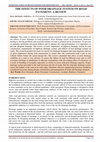
This study is carried out to review various research works carried out by researchers on
the effe... more This study is carried out to review various research works carried out by researchers on
the effects of poor drainage on road pavement. Poor drainage causes early pavement distresses
leading to driving problems and structural failures of road as pointed out by researchers. To prevent
or minimize premature pavement failures and to enhance the road performance, it is imperative to
provide adequate drainage. The review covered: importance of highway drainage system in roa
d
construction, requirements of highway drainage system, and effects of bad drainage system on
roads. The research pointed out areas of concern for drainage designers and road engineers
that are
of great importance during road construction to ensure that, the constructed road is put to use
without failure before the actual design life. The review concluded that effect of poor drainage
condition on a road is very adverse. It causes the failure of road in different way
s and as well
economic hardship on inhabitants of affected communities with devastating effect of sicknesses as
a result of breeding of mosquito especially on streets in towns with poor drainage capacity. Proper
drainage system provided to the road increases the life of roads. But the improper drainage system
causes the failure of the road at its early edge. Therefore effective engineering pr
actices should be
considered necessary during design, construction and management of roads and drainage channels.
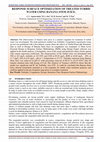
The effectiveness of banana stem juice as a natural coagulant for treatment of turbid
water was i... more The effectiveness of banana stem juice as a natural coagulant for treatment of turbid
water was investigated. The main parameter studied was Turbidity. Coagulation experiments using
jar test was performed with a flocculation system where the effects of Turbid Water pH, Retention
time as well as Dosage of Banana Stem Juice on coagulation was examined. A Three Level
Factorial Design in Response Surface Methodology (RSM) using Design Expert software was
applied in the model analysis. Consequently, most of the actual and predicted values closely agreed
with various regression coefficients. The characteristics of the Turbid water was determined with
TSS at 222 mg/L, turbidity at 143 NTU and COD at 89.36 mg/L, BOD at 44.68 mg/L, DO
1
at
11.7 mg/L, DO
5
at 6.93 mg/L, pH at 7, Temperature at 27.3°C
. Turbidity reduction using Banana
Stem Juice was achieved at pH 6.5 with percentage removal of 88.54 % (16.39 NTU) after 60
minutes retention time with dosage of 8 ml. The Analysis of Variance (ANOVA) shows that the
model was significant and R
2
for Turbidity, was 0.99. It could be concluded that Banana Stem
Juice showed tremendous potential as a bio-coagulant for turbid water treatment purposes and
could be applied in the pre-treatment stage prior to secondary treatment.
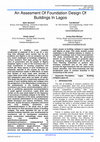
A building, once properly constructed is expected to be in use for a very long time. Although eve... more A building, once properly constructed is expected to be in use for a very long time. Although every society has its own problems and Nigeria is not an exception yet the very recent challenges of buildings collapsing in various locations have been giving the various arms of government and the people of Nigeria sleepless nights in view of the enormous loss of huge investments in housing, properties and human life. News reports of such incidences are frequently reported in the country by both the print and electronic media. In 2006 alone, no fewer than thirteen of such cases were recorded in Lagos State alone while statistics of the previous and subsequent years were not better off either. This study was set out to empirically ascertain the causes of such building failure and collapse from the perspective of the stakeholders (comprising of the professionals in the building industry, contractors and house owners/developers) with a view to proffering appropriate recommendations to guide against occurrence, Lagos State was chosen as the case study based on the frequency of occurrence of building collapse in the State. To achieve the objective of the study, questionnaires were randomly administered on the professional; Estate Surveyors and valuers. Architects, Town Planners, Quality Surveyors, Engineers (structural and civil), building contractors and Landlords/developers in the study area to seek their opinion on their perceived causes of building collapse. The study identified the use of substandard building materials, poor workmanship by contractors, use of incompetent contractors, faulty construction methodology, heavy down pour, non-compliance with specifications/standards by developers/contractors, inadequate/lack of supervision/inspection/monitoring, structural defects, defective design/structure, illegal conversion/alterations/additions to existing structures and dilapidating structures as the major causes of building collapse in Lagos State and Nigeria at large. This study reviews current challenges in the building industry in relation to collapse of buildings, loss of lives and properties. The study recommends that the government should, on one hand, embark on proactive steps by mustering enough political will to allow the Town Planning Authorities to perform their functions unfettered and on the other hand, provide the legal framework that can improve and ensure smoother, less time-consuming and less burdensome ways to conduct business in the functioning of law courts.
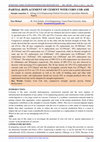
This study concerns the investigation of concrete produced by partial replacement of
cement with ... more This study concerns the investigation of concrete produced by partial replacement of
cement with corn cob ash (CCA). Corn cob ash was obtained and used to replace cement partially
in specified ratios of 5%, 10%, 15%, 20% and 25%. Concrete cubes were cast and cured in ages
of 7, 14 and 28 days respectively. While concrete beams were cast and cured for 28 days.
Compressive strength test was carried out on the cubes and the flexural strength on beam. The
results showed that the concrete strength decreased with increasing replacement with the corn cob
ash (CCA). The 28 days compressive strength for 5% replacement was 28.78N/mm
2
, 10%
replacement was 26.22N/mm
2
, 15 % replacement was 22.33N/mm
2
, 20% replacement was
20.27N/mm
2
and 25% replacement was 17.33N/mm
2
respectively while its flexural strength for
same age for 5% replacement was 9.98N/mm
2
, 10% replacement was 8.58N/mm
2
, 15%
replacement was 7.82N/mm
2
, 20% replacement was 6.56N/mm
2
and 25% replacement was
5.72N/mm
2
. The initial and final setting time of OPC-CCA at 10% replacement was observed to
be 168minutes and 305minutes respectively. The density of OPC-CCA was also observed to
decrease with increasing CCA replacement. The 28 day density for 10% CCA replacement for
concrete cube was 2373.33kg/m
3
and that of rectangular concrete beam was 2575kg/m
3
. The
specific gravity of CCA was 2.55. It was concluded that CCA can be used as partial replacement
for cement in concrete production as well as for walls of building units and other mild
construction works, and replacement should not exceed 10% as strength produced above this
replacement level may not be adequate for strength requirements.
In this work, we studied that Power Series Method is the standard basic method for
solving linear... more In this work, we studied that Power Series Method is the standard basic method for
solving linear differential equations with variable coefficients. The solutions usually take the form
of power series; this explains the name Power series method. We review some special second order
ordinary differential equations. Power series Method is described at ordinary points as well as at
singular points (which can be removed called Frobenius Method) of differential equations. We
present a few examples on this method by solving special second order ordinary differential
equations.
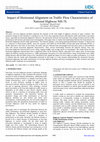
Two-lane, two-way highway facilities represent the majority of the total length of highway networ... more Two-lane, two-way highway facilities represent the majority of the total length of highway network in many countries. The geometric design of such facilities is considered as one of the most important factors affecting the traffic performance and safety issues, especially the horizontal alignment. However, the interaction between the horizontal curve design elements and the traffic performance still unclear and needs more investigations. This paper aims to explore the relationship between the characteristics of horizontal alignment and the traffic performance. The follower density, a new and promising performance measure, is herein used as a measure of effectiveness (MOE), since the currently used MOE (in HCM-2000), percent-time-spent-following (PTSF), is hardly observed in the field. In this study, the traffic data are collected from mid-tangent and mid-curve points at nine different sites with various horizontal alignment characteristics. Then, several relationships between the follower density, flow rate, horizontal alignment characteristics (curve radius, tangent length), and average speed are investigated. The results shows that the horizontal alignment characteristics have a significant effect on the follower density, especially curve radius value, by decreasing radius, the follower density increases (i.e., traffic performance decreases). It is also noticed that a value of horizontal curve radius falling between 400 and 450m seems to be a threshold of the significant impact of curve radius on traffic performance. It is worth to mention that the results and relationships presented in this paper is a step towards understanding the interaction between horizontal alignment and traffic performance at two-lane highway facilities and more investigation at other locations and under different traffic conditions are recommended.

ABSTRACT
The issue of flooding i
n Makurdi
is increasing
in an alarming rate and it has become ob... more ABSTRACT
The issue of flooding i
n Makurdi
is increasing
in an alarming rate and it has become obvious more
control is required of surface discharge from areas of
road, housing and industries to proper water course in
order to avoid excessive flooding downstream. The
purpose of this work is to des
ign an adequate drainage
system that can remove excess storm water flow from an
area of the Owners occupier Estate in Makurdi to proper
water courses. Before this design a survey was carried
out in this area to obtain its natural slope from the
hydrologica
l data of the area, the rainfall intensities for
various rainfall duration were obtained based on
Sharman’s equation. The return period of twenty five
years was used. Rational
formula was used to estimate
the various channel capacities of the drain. Having
consulted relevant literature and guided by the federal
ministry of works Highway manual, 2013, part 1, volume
iv, the results obtained
showed that the drainage sections
provided can adequately handle the drainage capacities of
the study area.
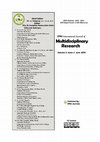
ABSTRACT
Soil sample from different areas of Ugboju
settlement of Oturkpo local government area o... more ABSTRACT
Soil sample from different areas of Ugboju
settlement of Oturkpo local government area of Benue
State comprising of Ogobia, Ondor and Ogoli
were
studied for their susceptibility to erosion. The main
objective of the study was to determine the soil properties
in relation to erodibility.
Fifteen Erosion sites, five each from the three
communities were studied and soil samples collected
from id
entified Erosion sites. Soil sampling and analysis
constituted the primary data sources while secondary
data were obtained from meteorological station of the
Nigerian Air force, Technical air command, Makurdi.
The core chemical properties of the soils we
re
PH, organic matter and So4, CI, Co3 Ions. Bulk density
was found to range between
1.46g/cm
3
to 2.85g/cm
3
,
moisture content ranged from
1.4% to 18.4%,
permeability of the soil samples was observed to be
between
4.4 x 10
-
3
to 0.6 x 10
-
1
while porosity ra
nged from
10% to 37%.
Specific gravity was found to have an
average value of
2.7g/cm
3
, and shear strength was
highest at 194.0 kpa and lowest at 5.1kpa.
Indices of Erodibility like Dispersion ratio (DR)
modified clay ratio (MCR), Erosion ratio (ER) and w
ater
stable aggregates (WSA) were calculated
Based
on these results, some of the areas under consideration
had poor moderate and high erodibility.
It is therefore recommended that control measures should
be carried out on areas belonging to high and very h
igh
erodibility class, while areas belonging to low and
moderate erodibility class should begin to introduce
erosion preventive measures to avoid further
degradation of the soil.
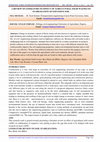
INTRODUCTION: Construction is a very vital stage in execution of civil engineering structures of ... more INTRODUCTION: Construction is a very vital stage in execution of civil engineering structures of any type, as much important as it is, it must not be trivialised as wrong construction of well-designed civil works may lead to poor safety and as well increase the cost of a specified project. Construction of standard quality roads require a lot of commitment, labour, good planning with good engineering and construction practices. Modern roads are engineered systems designed to spread or carry wheel loads on surface layer systems which are stiff down to the less stiff layers called the sub grade. The subgrade which is an important part of the road structure usually is considered to be a weak layer, since road construction is executed on the soil, different types of soils are met along the stretch of a proposed alignment, however, black cotton soil also known as expansive soils seem to be the most challenging type of soil encountered by engineers due to the presence of montmorrillonite which is a mineral that is highly unstable thus leading to shrinking and swelling of this type of soil on slight change in moisture content of back cotton soil. Since it is not only uneconomical to excavate soils with poor engineering characteristics and replace from borrow sites with soil having better engineering properties but as well constitute environmental hazards, the use of material wastes that would have constituted such environmental hazards to the society through indiscriminate disposal or wrong methods of incineration are put back into the soil to improve the engineering properties such as California Bearing ratio(CBR), Unconfined Compressive strength(UCS), plasticity, liquid limit, maximum dry density (MDD), optimum moisture content(OMC) etc. The improvement of unstable soil is thus called soil stabilization. AIM: This research work is geared towards presenting a literature review on effect of agricultural solid wastes (ASW) on stabilization of expansive soil, putting in place the gap that needs to be bridged with more research on more (ASW). LITERATURE REVIEW ON SOIL STABILIZATION: Rice Husk Ash (RHA)
Conference Presentations by TIZA MICHAEL. R.Engr.COREN, MNSE, Aff.MASCE,M.IAENG, B.Eng(Nigeria), MBA,M.Tech(India)

This article presents the results obtained from Vibro-compaction of loosely bond clayey soil. It ... more This article presents the results obtained from Vibro-compaction of loosely bond clayey soil. It was observed that there was maximum settlement when load was applied without encasement or stones. In the case of stone columns without encasement, the settlement decreased as compared to the first case without encasement and stones. In the case where geo textile encasement was used the settlement was observed to have decreased further as compared to the previous two cases, in the case where encasement rubber sheet was used there was further decrement in settlement, though compared to the difference experienced in other cases, it was less, while in the case where plastic, it was observed that there was much more decrement in settlement. It was generally observed that at the initial stage of application of load, the results where the almost the same but varied as there was increment in pressure. It can be seen from the results presented that use of different materials as encasements reduced significantly the settlement thus , increasing considerably the soil bearing capacity.
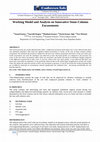
This article presents the results obtained from Vibro-compaction of loosely bond clayey soil. It ... more This article presents the results obtained from Vibro-compaction of loosely bond clayey soil. It was observed that there was maximum settlement when load was applied without encasement or stones. In the case of stone columns without encasement, the settlement decreased as compared to the first case without encasement and stones. In the case where geo textile encasement was used the settlement was observed to have decreased further as compared to the previous two cases, in the case where encasement rubber sheet was used there was further decrement in settlement, though compared to the difference experienced in other cases, it was less, while in the case where plastic, it was observed that there was much more decrement in settlement. It was generally observed that at the initial stage of application of load, the results where the almost the same but varied as there was increment in pressure. It can be seen from the results presented that use of different materials as encasements reduced significantly the settlement thus , increasing considerably the soil bearing capacity.










Uploads
Papers by TIZA MICHAEL. R.Engr.COREN, MNSE, Aff.MASCE,M.IAENG, B.Eng(Nigeria), MBA,M.Tech(India)
Christians using NIFES group in University of Agriculture as a typical case study, this work was done with
the use of questionnaires, primary data was collected from the field, analysed, interpreted and discussed in
the content of this work. The total number of questionnaire received were 128. The data was received from
Nigeria fellowship of evangelical students (NIFES) University of Agriculture Makurdi. The result shows
that at least 58% of the students study their bibles at least once in a day, 37% twice or more a day and 5%
do not study at all. At least 44% verify what they hear from bible discussions, about 34% have never heard
of inductive Bible study, about 30% of those who had heard before heard in NIFES weekly fellowship
meetings, 27% heard from special programmes organised by NIFES and 9% heard from their local
churches. According to the results, 65% study their Bibles inductively,87% affirmed they get inspiration
from Inductive Bible study while 83% showed they had inspiration for righteousness,80% said Inductive
bible study has played important roles in their lives, 82% are very satisfied with this method of study, 80%
accepts this method answers many doubting questions in their minds, 82% have spiritual benefits of the
study and about 81% have had their faith increased as a result of inductive Bible studies. It was concluded
that Inductive Bible study has a highly positive impact on the students and is as well a successful tool in
improving the efficacy of Christian Living.
the effects of poor drainage on road pavement. Poor drainage causes early pavement distresses
leading to driving problems and structural failures of road as pointed out by researchers. To prevent
or minimize premature pavement failures and to enhance the road performance, it is imperative to
provide adequate drainage. The review covered: importance of highway drainage system in roa
d
construction, requirements of highway drainage system, and effects of bad drainage system on
roads. The research pointed out areas of concern for drainage designers and road engineers
that are
of great importance during road construction to ensure that, the constructed road is put to use
without failure before the actual design life. The review concluded that effect of poor drainage
condition on a road is very adverse. It causes the failure of road in different way
s and as well
economic hardship on inhabitants of affected communities with devastating effect of sicknesses as
a result of breeding of mosquito especially on streets in towns with poor drainage capacity. Proper
drainage system provided to the road increases the life of roads. But the improper drainage system
causes the failure of the road at its early edge. Therefore effective engineering pr
actices should be
considered necessary during design, construction and management of roads and drainage channels.
water was investigated. The main parameter studied was Turbidity. Coagulation experiments using
jar test was performed with a flocculation system where the effects of Turbid Water pH, Retention
time as well as Dosage of Banana Stem Juice on coagulation was examined. A Three Level
Factorial Design in Response Surface Methodology (RSM) using Design Expert software was
applied in the model analysis. Consequently, most of the actual and predicted values closely agreed
with various regression coefficients. The characteristics of the Turbid water was determined with
TSS at 222 mg/L, turbidity at 143 NTU and COD at 89.36 mg/L, BOD at 44.68 mg/L, DO
1
at
11.7 mg/L, DO
5
at 6.93 mg/L, pH at 7, Temperature at 27.3°C
. Turbidity reduction using Banana
Stem Juice was achieved at pH 6.5 with percentage removal of 88.54 % (16.39 NTU) after 60
minutes retention time with dosage of 8 ml. The Analysis of Variance (ANOVA) shows that the
model was significant and R
2
for Turbidity, was 0.99. It could be concluded that Banana Stem
Juice showed tremendous potential as a bio-coagulant for turbid water treatment purposes and
could be applied in the pre-treatment stage prior to secondary treatment.
cement with corn cob ash (CCA). Corn cob ash was obtained and used to replace cement partially
in specified ratios of 5%, 10%, 15%, 20% and 25%. Concrete cubes were cast and cured in ages
of 7, 14 and 28 days respectively. While concrete beams were cast and cured for 28 days.
Compressive strength test was carried out on the cubes and the flexural strength on beam. The
results showed that the concrete strength decreased with increasing replacement with the corn cob
ash (CCA). The 28 days compressive strength for 5% replacement was 28.78N/mm
2
, 10%
replacement was 26.22N/mm
2
, 15 % replacement was 22.33N/mm
2
, 20% replacement was
20.27N/mm
2
and 25% replacement was 17.33N/mm
2
respectively while its flexural strength for
same age for 5% replacement was 9.98N/mm
2
, 10% replacement was 8.58N/mm
2
, 15%
replacement was 7.82N/mm
2
, 20% replacement was 6.56N/mm
2
and 25% replacement was
5.72N/mm
2
. The initial and final setting time of OPC-CCA at 10% replacement was observed to
be 168minutes and 305minutes respectively. The density of OPC-CCA was also observed to
decrease with increasing CCA replacement. The 28 day density for 10% CCA replacement for
concrete cube was 2373.33kg/m
3
and that of rectangular concrete beam was 2575kg/m
3
. The
specific gravity of CCA was 2.55. It was concluded that CCA can be used as partial replacement
for cement in concrete production as well as for walls of building units and other mild
construction works, and replacement should not exceed 10% as strength produced above this
replacement level may not be adequate for strength requirements.
solving linear differential equations with variable coefficients. The solutions usually take the form
of power series; this explains the name Power series method. We review some special second order
ordinary differential equations. Power series Method is described at ordinary points as well as at
singular points (which can be removed called Frobenius Method) of differential equations. We
present a few examples on this method by solving special second order ordinary differential
equations.
The issue of flooding i
n Makurdi
is increasing
in an alarming rate and it has become obvious more
control is required of surface discharge from areas of
road, housing and industries to proper water course in
order to avoid excessive flooding downstream. The
purpose of this work is to des
ign an adequate drainage
system that can remove excess storm water flow from an
area of the Owners occupier Estate in Makurdi to proper
water courses. Before this design a survey was carried
out in this area to obtain its natural slope from the
hydrologica
l data of the area, the rainfall intensities for
various rainfall duration were obtained based on
Sharman’s equation. The return period of twenty five
years was used. Rational
formula was used to estimate
the various channel capacities of the drain. Having
consulted relevant literature and guided by the federal
ministry of works Highway manual, 2013, part 1, volume
iv, the results obtained
showed that the drainage sections
provided can adequately handle the drainage capacities of
the study area.
Soil sample from different areas of Ugboju
settlement of Oturkpo local government area of Benue
State comprising of Ogobia, Ondor and Ogoli
were
studied for their susceptibility to erosion. The main
objective of the study was to determine the soil properties
in relation to erodibility.
Fifteen Erosion sites, five each from the three
communities were studied and soil samples collected
from id
entified Erosion sites. Soil sampling and analysis
constituted the primary data sources while secondary
data were obtained from meteorological station of the
Nigerian Air force, Technical air command, Makurdi.
The core chemical properties of the soils we
re
PH, organic matter and So4, CI, Co3 Ions. Bulk density
was found to range between
1.46g/cm
3
to 2.85g/cm
3
,
moisture content ranged from
1.4% to 18.4%,
permeability of the soil samples was observed to be
between
4.4 x 10
-
3
to 0.6 x 10
-
1
while porosity ra
nged from
10% to 37%.
Specific gravity was found to have an
average value of
2.7g/cm
3
, and shear strength was
highest at 194.0 kpa and lowest at 5.1kpa.
Indices of Erodibility like Dispersion ratio (DR)
modified clay ratio (MCR), Erosion ratio (ER) and w
ater
stable aggregates (WSA) were calculated
Based
on these results, some of the areas under consideration
had poor moderate and high erodibility.
It is therefore recommended that control measures should
be carried out on areas belonging to high and very h
igh
erodibility class, while areas belonging to low and
moderate erodibility class should begin to introduce
erosion preventive measures to avoid further
degradation of the soil.
Conference Presentations by TIZA MICHAEL. R.Engr.COREN, MNSE, Aff.MASCE,M.IAENG, B.Eng(Nigeria), MBA,M.Tech(India)
Christians using NIFES group in University of Agriculture as a typical case study, this work was done with
the use of questionnaires, primary data was collected from the field, analysed, interpreted and discussed in
the content of this work. The total number of questionnaire received were 128. The data was received from
Nigeria fellowship of evangelical students (NIFES) University of Agriculture Makurdi. The result shows
that at least 58% of the students study their bibles at least once in a day, 37% twice or more a day and 5%
do not study at all. At least 44% verify what they hear from bible discussions, about 34% have never heard
of inductive Bible study, about 30% of those who had heard before heard in NIFES weekly fellowship
meetings, 27% heard from special programmes organised by NIFES and 9% heard from their local
churches. According to the results, 65% study their Bibles inductively,87% affirmed they get inspiration
from Inductive Bible study while 83% showed they had inspiration for righteousness,80% said Inductive
bible study has played important roles in their lives, 82% are very satisfied with this method of study, 80%
accepts this method answers many doubting questions in their minds, 82% have spiritual benefits of the
study and about 81% have had their faith increased as a result of inductive Bible studies. It was concluded
that Inductive Bible study has a highly positive impact on the students and is as well a successful tool in
improving the efficacy of Christian Living.
the effects of poor drainage on road pavement. Poor drainage causes early pavement distresses
leading to driving problems and structural failures of road as pointed out by researchers. To prevent
or minimize premature pavement failures and to enhance the road performance, it is imperative to
provide adequate drainage. The review covered: importance of highway drainage system in roa
d
construction, requirements of highway drainage system, and effects of bad drainage system on
roads. The research pointed out areas of concern for drainage designers and road engineers
that are
of great importance during road construction to ensure that, the constructed road is put to use
without failure before the actual design life. The review concluded that effect of poor drainage
condition on a road is very adverse. It causes the failure of road in different way
s and as well
economic hardship on inhabitants of affected communities with devastating effect of sicknesses as
a result of breeding of mosquito especially on streets in towns with poor drainage capacity. Proper
drainage system provided to the road increases the life of roads. But the improper drainage system
causes the failure of the road at its early edge. Therefore effective engineering pr
actices should be
considered necessary during design, construction and management of roads and drainage channels.
water was investigated. The main parameter studied was Turbidity. Coagulation experiments using
jar test was performed with a flocculation system where the effects of Turbid Water pH, Retention
time as well as Dosage of Banana Stem Juice on coagulation was examined. A Three Level
Factorial Design in Response Surface Methodology (RSM) using Design Expert software was
applied in the model analysis. Consequently, most of the actual and predicted values closely agreed
with various regression coefficients. The characteristics of the Turbid water was determined with
TSS at 222 mg/L, turbidity at 143 NTU and COD at 89.36 mg/L, BOD at 44.68 mg/L, DO
1
at
11.7 mg/L, DO
5
at 6.93 mg/L, pH at 7, Temperature at 27.3°C
. Turbidity reduction using Banana
Stem Juice was achieved at pH 6.5 with percentage removal of 88.54 % (16.39 NTU) after 60
minutes retention time with dosage of 8 ml. The Analysis of Variance (ANOVA) shows that the
model was significant and R
2
for Turbidity, was 0.99. It could be concluded that Banana Stem
Juice showed tremendous potential as a bio-coagulant for turbid water treatment purposes and
could be applied in the pre-treatment stage prior to secondary treatment.
cement with corn cob ash (CCA). Corn cob ash was obtained and used to replace cement partially
in specified ratios of 5%, 10%, 15%, 20% and 25%. Concrete cubes were cast and cured in ages
of 7, 14 and 28 days respectively. While concrete beams were cast and cured for 28 days.
Compressive strength test was carried out on the cubes and the flexural strength on beam. The
results showed that the concrete strength decreased with increasing replacement with the corn cob
ash (CCA). The 28 days compressive strength for 5% replacement was 28.78N/mm
2
, 10%
replacement was 26.22N/mm
2
, 15 % replacement was 22.33N/mm
2
, 20% replacement was
20.27N/mm
2
and 25% replacement was 17.33N/mm
2
respectively while its flexural strength for
same age for 5% replacement was 9.98N/mm
2
, 10% replacement was 8.58N/mm
2
, 15%
replacement was 7.82N/mm
2
, 20% replacement was 6.56N/mm
2
and 25% replacement was
5.72N/mm
2
. The initial and final setting time of OPC-CCA at 10% replacement was observed to
be 168minutes and 305minutes respectively. The density of OPC-CCA was also observed to
decrease with increasing CCA replacement. The 28 day density for 10% CCA replacement for
concrete cube was 2373.33kg/m
3
and that of rectangular concrete beam was 2575kg/m
3
. The
specific gravity of CCA was 2.55. It was concluded that CCA can be used as partial replacement
for cement in concrete production as well as for walls of building units and other mild
construction works, and replacement should not exceed 10% as strength produced above this
replacement level may not be adequate for strength requirements.
solving linear differential equations with variable coefficients. The solutions usually take the form
of power series; this explains the name Power series method. We review some special second order
ordinary differential equations. Power series Method is described at ordinary points as well as at
singular points (which can be removed called Frobenius Method) of differential equations. We
present a few examples on this method by solving special second order ordinary differential
equations.
The issue of flooding i
n Makurdi
is increasing
in an alarming rate and it has become obvious more
control is required of surface discharge from areas of
road, housing and industries to proper water course in
order to avoid excessive flooding downstream. The
purpose of this work is to des
ign an adequate drainage
system that can remove excess storm water flow from an
area of the Owners occupier Estate in Makurdi to proper
water courses. Before this design a survey was carried
out in this area to obtain its natural slope from the
hydrologica
l data of the area, the rainfall intensities for
various rainfall duration were obtained based on
Sharman’s equation. The return period of twenty five
years was used. Rational
formula was used to estimate
the various channel capacities of the drain. Having
consulted relevant literature and guided by the federal
ministry of works Highway manual, 2013, part 1, volume
iv, the results obtained
showed that the drainage sections
provided can adequately handle the drainage capacities of
the study area.
Soil sample from different areas of Ugboju
settlement of Oturkpo local government area of Benue
State comprising of Ogobia, Ondor and Ogoli
were
studied for their susceptibility to erosion. The main
objective of the study was to determine the soil properties
in relation to erodibility.
Fifteen Erosion sites, five each from the three
communities were studied and soil samples collected
from id
entified Erosion sites. Soil sampling and analysis
constituted the primary data sources while secondary
data were obtained from meteorological station of the
Nigerian Air force, Technical air command, Makurdi.
The core chemical properties of the soils we
re
PH, organic matter and So4, CI, Co3 Ions. Bulk density
was found to range between
1.46g/cm
3
to 2.85g/cm
3
,
moisture content ranged from
1.4% to 18.4%,
permeability of the soil samples was observed to be
between
4.4 x 10
-
3
to 0.6 x 10
-
1
while porosity ra
nged from
10% to 37%.
Specific gravity was found to have an
average value of
2.7g/cm
3
, and shear strength was
highest at 194.0 kpa and lowest at 5.1kpa.
Indices of Erodibility like Dispersion ratio (DR)
modified clay ratio (MCR), Erosion ratio (ER) and w
ater
stable aggregates (WSA) were calculated
Based
on these results, some of the areas under consideration
had poor moderate and high erodibility.
It is therefore recommended that control measures should
be carried out on areas belonging to high and very h
igh
erodibility class, while areas belonging to low and
moderate erodibility class should begin to introduce
erosion preventive measures to avoid further
degradation of the soil.
seeks to understand how their daily academic activities are influenced by poor road network, their semester and overall academic
performance was investigated. The method employed was through development of questionnaires’ and distributing among
University undergraduates who usually travel on a very poor road condition to and fro University for their academic activities. The
result shows that the specific academic performance of students due to poor road condition is significantly affected and the general
academic activities of students is affected by poor pavement condition.